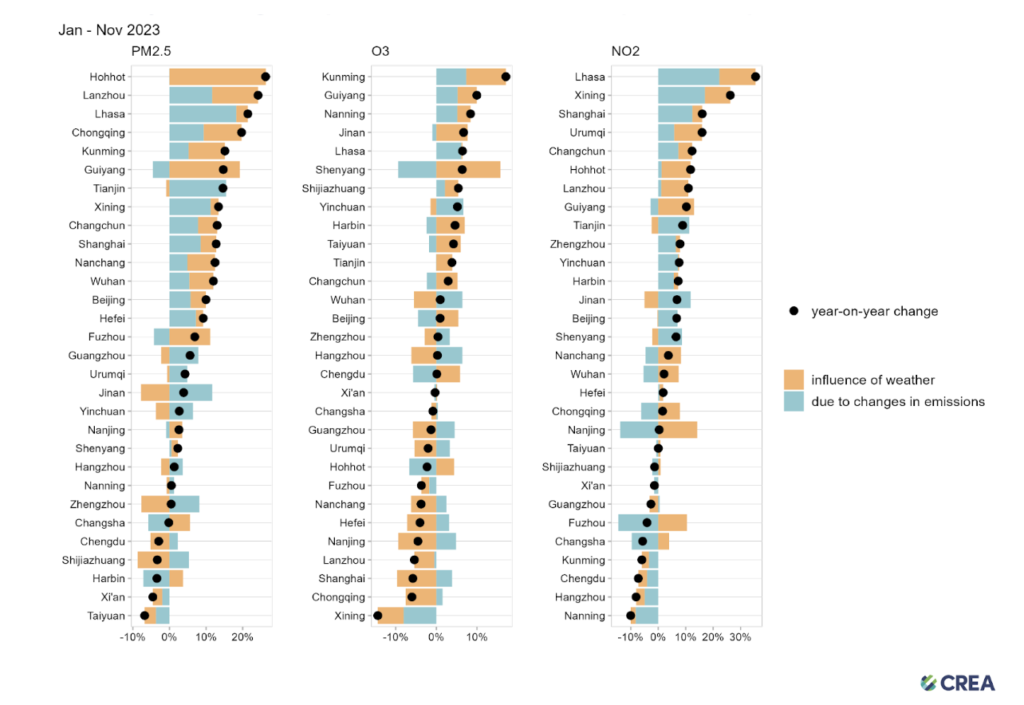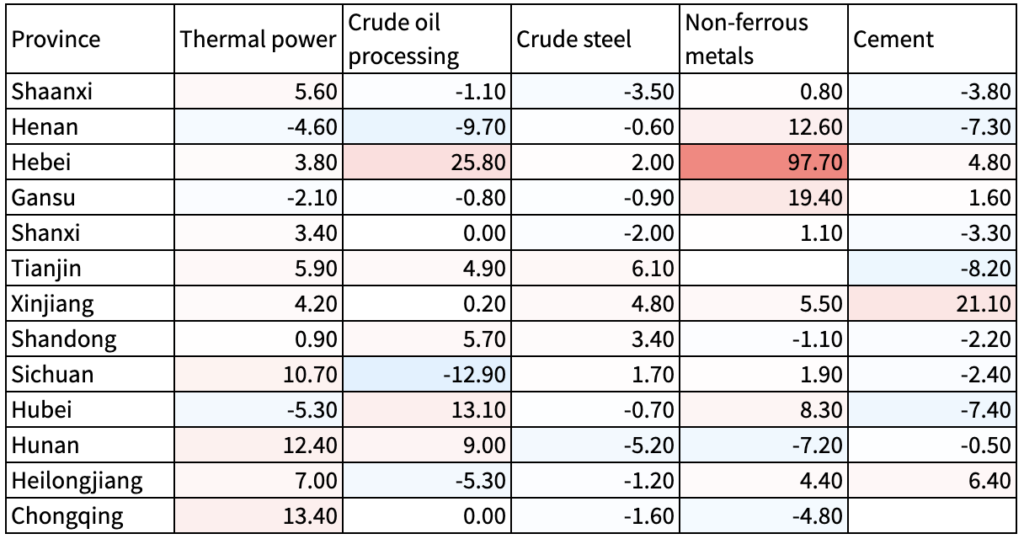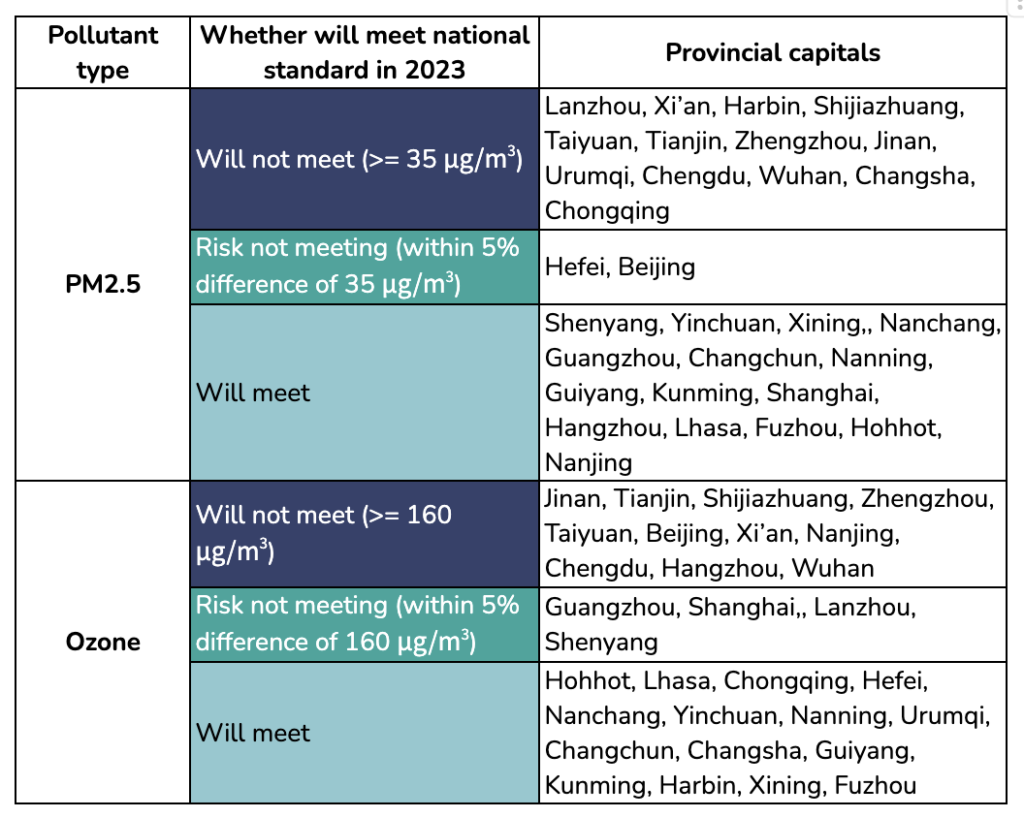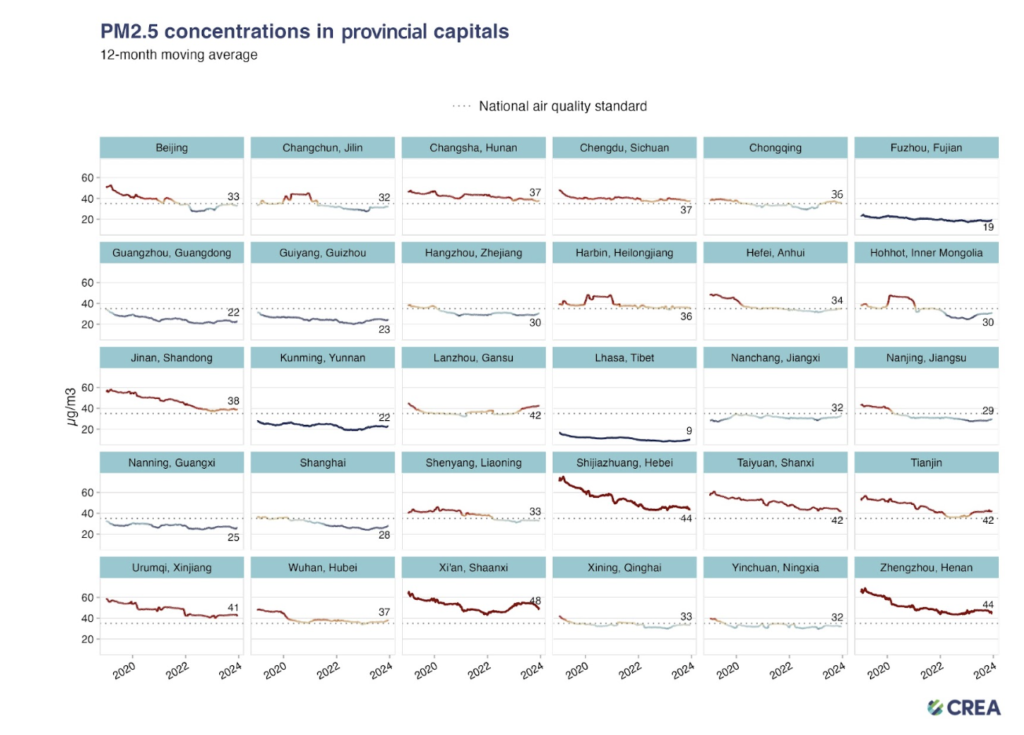Key findings
- 2023 is the first year that China’s national average PM2.5 level has increased year-on-year since the beginning of China’s “war on pollution” in 2013. 80% of the provincial capitals, including Beijing, have seen PM2.5 level increase on year.
- In 2023, 13 out of China’s 31 provincial capitals have not met the national standard for PM2.5, and 11 provincial capitals have not met the standard for ozone. They are concentrated in the northern key air pollution control regions and in central China.
- Nearly half of the capital cities that have not met the PM2.5 standard have improved air quality compared to the previous year, while all cities that are in compliance with the standard have seen increases. This shows efforts are also needed from places where air quality doesn’t exceed the national standards.
- The rebound in pollution levels was due to both increases in emissions and more unfavourable weather conditions in 2023, compared with the previous year. This is seen using CREA’s deweathering algorithm, which disaggregates the impact of changes in weather conditions and changes in emissions.
- The largest relative increases in PM2.5 pollution levels attributed to increases in emissions were in Lhasa (in Tibet), Tianjin and Jinan (in Shandong), at 18.2%, 15.5% and 11.7% on year, respectively. However, Lhasa’s PM2.5 levels are very low so the changes are small in absolute terms.
- The overall increase in human-caused emissions has pushed the pollution level higher, in addition to unfavourable weather conditions. Coal production and thermal power production in areas where the PM2.5 standard was not met have increased by 4.4% and 4.3%, respectively, on year, indicating a larger use of fossil energy. Similar increases were also seen in oil and metal industries.
Air pollution rebounded in China in 2023
In the previous 11 months, Beijing has been shrouded in PM2.5 pollution in more than one tenth of the days, whereas PM2.5 concentrations went beyond twice the national standard (35µg/m3). The PM2.5 concentration in Beijing increased by 3.2% from January to November year-on-year, and it increased for the whole country by 3.6% year-on-year. The air pollution rebound in China marks 2023 as the first year that the national average PM2.5 level increased since the first ever comprehensive air pollution action plan released in 2013.
Close to year end, 13 out of 31 provincial capitals are off track to meet the national standard for PM2.5, and 11 provincial capitals are off track for the national standard for ozone, exacerbating potential health impacts. The provincial capitals with the most severe PM2.5 pollution and ozone pollution are highly correlated, and seven of them risk violating both standards for PM2.5 and ozone: Xi’an (in Shaanxi), Zhengzhou (in Henan), Shijiazhuang (in Hebei), Taiyuan (in Shanxi), Tianjin, Jinan (in Shandong) and Chengdu (in Sichuan). Most of these cities are in the north and are within Fenwei plain and Jing-jin-ji area, two of the key control regions for air pollution in China.
80% of the provincial capitals have seen increased PM2.5 levels on year. Cities that have an increased PM2.5 pollution level year-on-year are not exactly the same as the cities which exceeded the national standard this year, indicating efforts are also needed from places where the air quality has not exceeded the national standards. Six of the provincial capitals that have not met the standard for PM2.5 (Changsha, Chengdu, Shijiazhuang, Harbin, Xi’an and Taiyuan) had decreased PM2.5 concentrations year-on-year, though the drop in Chengdu and Shijiazhuang was more due to favourable weather conditions, contradicting the influence of increased emissions.
Beijing’s year-on-year increase in air pollutants
Frequent smog episodes that took place in February and March raised the whole country’s PM2.5 concentration to the highest point of the year by this March, that is 46µg/m3, and raised Beijing’s PM2.5 concentration up to 47.8µg/m3, an increase of 30.6% from the same period last year.
By the end of this November, the 12-month moving average of PM2.5 in Beijing reached 32.6µg/m3, which is a 7.7% increase from last year. Furthermore, its ozone concentration over 12 months (90th percentile) has come to 184µg/m3, exceeding the national standard of 160µg/m3 by 15%. [Further reading: Beijing’s air quality meets national standards: a major milestone in China’s war on smog].
Reasons for the rebound
This year, unfavourable weather conditions have promoted PM2.5 pollution in certain places, particularly in Hohhot (in Inner Mongolia), Guiyang (in Guizhou) and Lanzhou (in Gansu), by 26.3%, 19.2% and 12.6% on year, respectively. However, the overall increase in human-caused emissions has pushed the pollution level higher. In Lhasa (in Tibet), Tianjin and Jinan (in Shandong), the influence of emissions has increased their PM2.5 concentrations by 18.2%, 15.5% and 11.7% on year, respectively.

Figure 1. Year-on-year changes in pollutant concentrations in provincial capitals; January to November 2023
Air pollution has long been correlated with the heavy industrial structure in China. Within the key control regions for air pollution, many cities like Taiyuan are well-known for coal-reliance and heavy industry development, and they have particular difficulty with meeting the national standards for air quality. In the provinces with capital cities that have not met the PM2.5 standard, their coal production accounts for 63.6% of the national total, among which the two provinces (Shanxi and Shaanxi) within the Fenwei plain account for 46.0% of the total coal production nationwide. In 2023, coal production in these areas increased by 4.4% compared to the same time last year, indicating a larger demand from the fossil fuel industry.
On the other hand, thermal power production increased on average by 4.3% on year in areas where the capital cities have not met the PM2.5 standard, while the average for the whole nation increased by 8.5%. A similar tendency can be seen in the other highly-polluting heavy industries, including crude oil processing and production of non-ferrous metals.
Table 1. Changes in output in highly energy & carbon intensive industries from January to October 2023, year-on-year

The rebound of air pollution has raised the alarm for the central government. Mid year, the minister from the Ministry of Ecology and Environment said the air pollution rebound in the first half of the year was correlated with increased high energy and carbon intensive industrial production after COVID restriction measures were lifted, apart from the unfavourable weather conditions. The State Council released the “Action Plan for Continuous Improvement of Air Quality” on 30 November, adding quantitative targets for a PM2.5 decrease nationwide and in key regions and Beijing by 2025 (Further reading: China’s new air pollution plan injects momentum into cleaning the air and reducing coal use).
Which provincial capitals will miss the target?
From the regional perspective, 62% of the provincial capitals in the north12 will not meet the national standard for PM2.5 this year, with the other 23% falling under the category of the risk of not meeting the standard. The capitals of four neighbouring provinces or municipalities in central China, Sichuan, Chongqing, Hunan and Hubei, will not meet the national standard for PM2.5 this year.
Among the capital cities that will not meet the national standard for PM2.5 this year, only Wuhan met it in the previous year. More than half of these cities have increased PM2.5 levels compared to the same period last year: Lanzhou, Chongqing, Tianjin, Wuhan, Urumqi, Zhengzhou and Jinan, sequenced from high to low according to their year-on-year ratios.
Table 2. Different groups of provincial capitals that either will not meet, risk not meeting, or will meet the national standards for PM2.5 and ozone, respectively, in 2023


Figure 2. PM2.5 concentrations in provincial capitals
New policy direction in 2023
Tackling air pollution is crucial not only for improving human health but also for mitigating climate change. Since China implemented the first comprehensive action plan on targeting air pollution in 2013, the national average PM2.5 concentration fell from 72µg/m3 in 2013 to 29µg/m3 in 2022, marking significant improvement in China’s air quality. However, it should be noted that the national standards for the main air pollutants in China are still far more relaxed than the guidelines provided by the World Health Organization, which set recommended annual PM2.5 level at 5µg/m3 and peak season ozone at 60µg/m3, and thus we should note that improving air quality in China requires higher awareness and continuous work.
The new action plan targeting air pollution control by 2025 is a step forward for Beijing. By setting Beijing’s target for PM2.5 at 32µg/m3, it shows a positive sign of setting the standard higher than the currently enforced national standard (35µg/m3). For this to be effective, we anticipate the central government will need strict enforcement to improve air quality and to adjust to a sustainable and high-quality development model.
About the data
Industrial output and power generation are based on Chinese government data, through Wind Financial Terminal. Some of the data is not included in public releases. Measured air quality data is compiled from Chinese government air quality monitoring stations. Weather-controlled air quality is derived from CREA’s deweathering algorithm. Our analysis projects the influence of weather conditions on air pollution levels using a machine-learning model trained on actual data for each city. The variation that cannot be explained by weather conditions is attributed to changes in emissions.
- The Central People’s Government of the People’s Republic of China. (2005). Geography distribution. https://www.gov.cn/test/2005-07/27/content_17425.htm
↩︎ - Northern provincial capitals referred to here are Beijing, Tianjin, Shijiazhuang, Jinan, Shenyang, Changchun, Harbin, Taiyuan, Zhengzhou, Xi’an, Lanzhou, Yinchuan and Hohhot. ↩︎